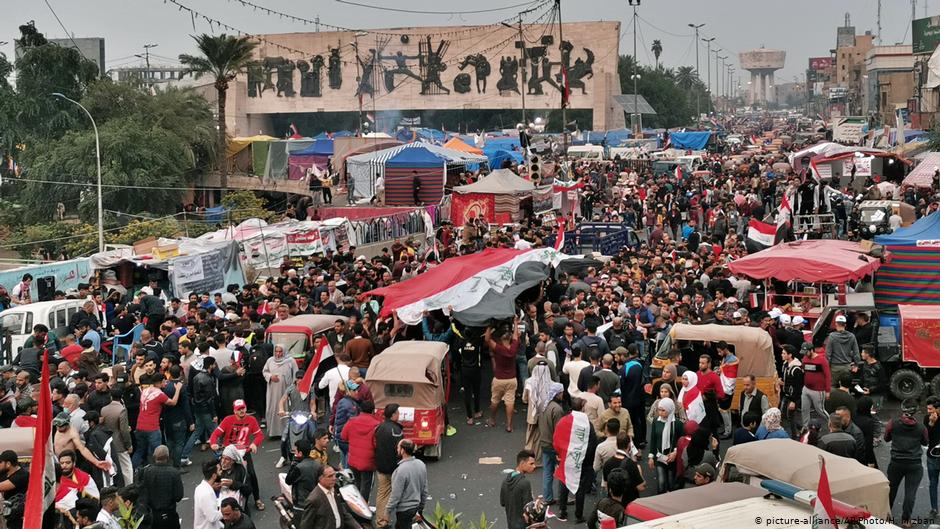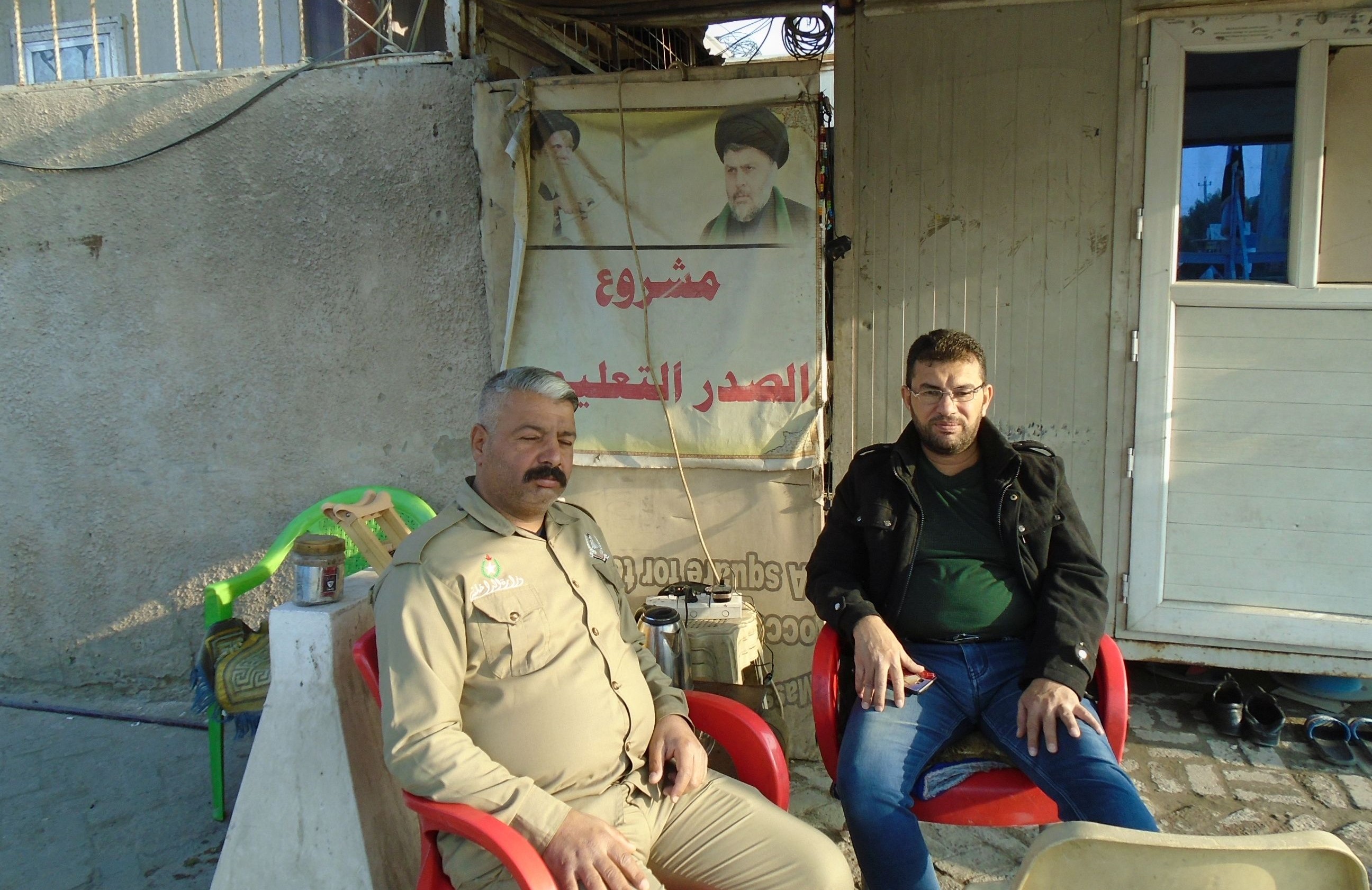Sadr City – a hotbed of resistance

"It's getting dirty now," says one demonstrator on Tahrir Square in Baghdad, when asked about the events of last weekend. It was the bloodiest two days in a long time since the protests began in Iraq on 1 October. In the capital alone, 25 people lost their lives. Across the country, almost 50 people are said to have been killed.
It began when thousands of supporters of the Shia Hashd al-Shaabi militia descended on the central protest camp of the anti-government demonstrators on Baghdad's Tahrir Square. In what was obviously a co-ordinated attack, the men approached the camp from all directions. Some of the militia-linked attackers carried Iraqi flags or the emblem of the paramilitary unit. Others held aloft the portrait of the respected Grand Ayatollah Ali al-Sistani, who had forced the government of Adel Abdul Mahdi to resign the previous Friday by calling on parliament to withdraw its support for the government.
Initially, the situation remained calm, but on the following day, shots were fired on Rasheed Street, which is only a stone's throw from Tahrir Square. Eye witnesses said that a real street battle ensued. Some say that the security forces opened fire on demonstrators. Others claim that the Shia militias were fighting each other for control of the street.
"We'll throw them all out!"
The Hashd al-Shaabi militia is closely linked to the Iranian Revolutionary Guards, which have played a key role in bankrolling and training the militia. It was also founded in order to fight the terrorist organisation IS. Increasingly, the protests are being directed at neighbouring Iran and its meddling in Iraqi politics. Most of the demonstrators on Tahrir Square come from Sadr City, the Shia district in Baghdad.

"We'll throw them out! We'll throw them all out!" Hussein sits confidently in his pillar box red tuk-tuk, a three-wheeled auto rickshaw, as he drives through the streets of "Medina al-Sadr", as the district is known in Arabic. Every morning at 7 a.m., he eats breakfast at one of the countless fast food eateries in the district, generally soup, machlama (an egg dish with tomatoes, onions, and cheese) and Iraqi hobbes, a diamond-shaped bread that is served warm around this time of day.
Hussein quite obviously enjoys his food; the 17-year-old is stout and stocky. During the day, he drives people around Sadr City, does the shopping for people who can no longer walk, or acts as a courier. At 9 p.m. sharp, he joins the demonstrators on Tahrir Square. He usually stays for about five hours.
The heroes of the protest movement
Hussein eventually brings his tuk-tuk to a halt on one of the main roads in Sadr City and points to a car park where row upon row of little yellow and red vehicles are parked. They have become the heroes of the protest movement. The "revolutionary newspaper" has been named after them and graffiti all over the district depict these nippy little auto rickshaws in action – sometimes even hovering in flight over everything.
Here in this car park in Sadr City, they are stationary. This is where they are washed and repaired upon returning from Tahrir Square; this is where they re-fuel before heading back there again. According to Hussein, they are not allowed to buy petrol at normal petrol stations; they have to buy cans of petrol on the street instead. And it's true: there are mobile tuk-tuk petrol stations all over Sadr City, selling either bottles or little cans of fuel.
There is no fuel for them in other districts, he says, just here. Hussein starts the engine and we are off again through the streets of Baghdad's stinking slum. Whenever it rains, as it often does at the moment, sewage and rain water often come together in puddles, festering on the cracked streets for days.
Baghdad's biggest slum
Sadr City is the biggest slum in the Iraqi capital. Most of the three million people who live here are Shia Arabs, and the majority of the population is poor. Anyone who gets on in life moves the outskirts of Sadr City, to Palestine Street, or even to another district altogether. But not many people manage to do that. Indeed, more people move to the district than move away from it. Sadr City is simply bursting at the seams.
Sadr City was founded in 1959 after the monarchy was overthrown. The new prime minister, General Abdel Karim Qasim, earmarked the zone as a settlement area for the Iraqis who were streaming into the capital from the southern provinces. Iraq's rural exodus had begun. The PM called the new district "Medina al-Thaura", the City of Revolution. And that is what Sadr City has once again become.
A revolution started by the people

Most of the people demonstrating on Baghdad's Tahrir Square come from here, as do the street fighters who conquer the bridges over the Tigris in the hope of being able to paralyse the city. "This is our revolution," says Hussein proudly. But this time, he adds, it was started by the people, not by the military, as it was in 1958. Many people are calling for Sadr City to return to its old name, "Medina al-Thaura".
"They all have to go," says Hussein again, quietly but forcefully. "They are all thieves and robbers – and now even murderers." As far as Hussein is concerned, the prime minister's resignation is not enough. And what about Iran? What about Iraq's neighbouring country, the target of so many demonstrators' ire? On this point, Hussein is more cagey. He looks around from left to right before tersely replying: "Iran is our government, and I am against the government."
That says it all. No one else that I speak to in Sadr City puts it as concisely as the young Hussein. Nevertheless, the mood is the same no matter whom I speak to. The people in Sadr City are fed up of clerics who do nothing to change the wretched status quo in the city and are only out to line their own pockets.
From Saddam City to Sadr City
After the Americans and British invaded Iraq in 2003, the district that at the time was known as Saddam City was renamed Sadr City in memory of Grand Ayatollah Mohammad Sadeq al-Sadr who was the father of the influential Iraqi Shia cleric, Muqtada al-Sadr, and was killed by Saddam. Most of the people who settled here were Shias, who were persecuted by the dictator.
Muqtada founded a militia, the Mahdi Army, which at one point had up to 50,000 recruits and controlled the district. But it didn't end there. The members of his militia received military training and struck fear into the hearts of the people of Baghdad. Death squadrons hunted down and killed anyone who had been in any way associated with the Saddam regime.
Iraq began to experience an unprecedented brain drain. The mere mention of the Mahdi Army or Sadr City was enough to terrify people. When the Americans withdrew from Iraq in 2011, Muqtada al-Sadr boasted that he had committed 6,000 attacks on U.S. troops. Sadr City was one of the biggest security threats for the American occupying forces.

Hussein lets us out in front of the Muqtada al-Sadr media centre. It is an imposing yellow sandstone building. Over the entrance is a poster of the murdered Grand Ayatollah who gave Sadr City its name. The building itself seems deserted. Not a soul is stirring. I see a police car parked to the right. Two men, one of whom is in uniform, are drinking tea.
While they don't want to give their names, they do start to talk. Three police officers were also killed during the fighting at the weekend. "We are siding with the protest movement," says the man in uniform. The other man adds: "we too have changed sides."
The faded legend of the Robin Hood of Sadr City
He eventually tells me that he is a soldier serving in the Iraqi Army who was injured recently during deployment on Tahrir Square. His foot is bandaged, and he is limping. "We were deceived," says the police officer when asked about the cause of the plight of those living in Sadr City.
When asked why, if this was the case, they voted for Muqtada al-Sadr and his people last year, both shrug their shoulders. The soldier says: "We believed them." In the meantime, a man who works at the media centre has arrived. He promises to organise a meeting with one of Muqtada al-Sadr's spokesmen. A request for a meeting on the telephone is rebuffed. Indeed, several requests are rejected in the same way. They don't want to speak to the press. Not now, anyway.
"Iraq for the Iraqis"
"Three-quarters of Muqtada's people are thieves," claims Haider, a tuk-tuk driver who is friendly with Hussein. "As are all the others." They have brought millions out of the country, he says, adding that some of them even have two passports. Muqtada's people are in six ministries, he claims, adding that for them, religion is a business "they use to keep us down."[embed:render:embedded:node:37503]
It is quite a turnaround: 45-year-old Muqtada al-Sadr used to like to portray himself as the champion of the poor, earned himself a reputation as the Robin Hood of Sadr City, fronted the protest movement in 2016 against the poor water and power supplies. His supporters stormed the Green Zone, Baghdad's heavily guarded government district, sat on the MPs' seats in parliament and demanded a say.
In May 2018, Muqtada al-Sadr's Sai'run alliance, which he founded himself and was something akin to a citizens' movement, emerged victorious from the elections. The mood was positive. People were ready for change – in Sadr City too. People felt great hope that life would improve if their people were in government. "But they deceived and tricked us," says Haider. Now, Muqtada al-Sadr drives a Ferrari, has made his son Iraq's ambassador to South America, and flies to car races in Qom. It is said that he is currently in Iran.
"We won't stop until they are all gone," say Hussein and Haider almost speaking as one. "Iraq for the Iraqis!" In the Mahdi Army, they learned to overcome their fear, says another tuk-tuk driver. This, he says, is standing them in good stead right now.
When I ask the young men about the fact that Muqtada al-Sadr had renamed his militia "Saraya Salam" (peace brigades) and has been talking about decommissioning its arms ever since its victory over Islamic State two years ago, they just wink. "If anyone is going to manage a revolution in Iraq," they say, "then it'll be the people in Sadr City."
Birgit Svensson
© Qantara.de 2019
Translated from the German by Aingeal Flanagan
